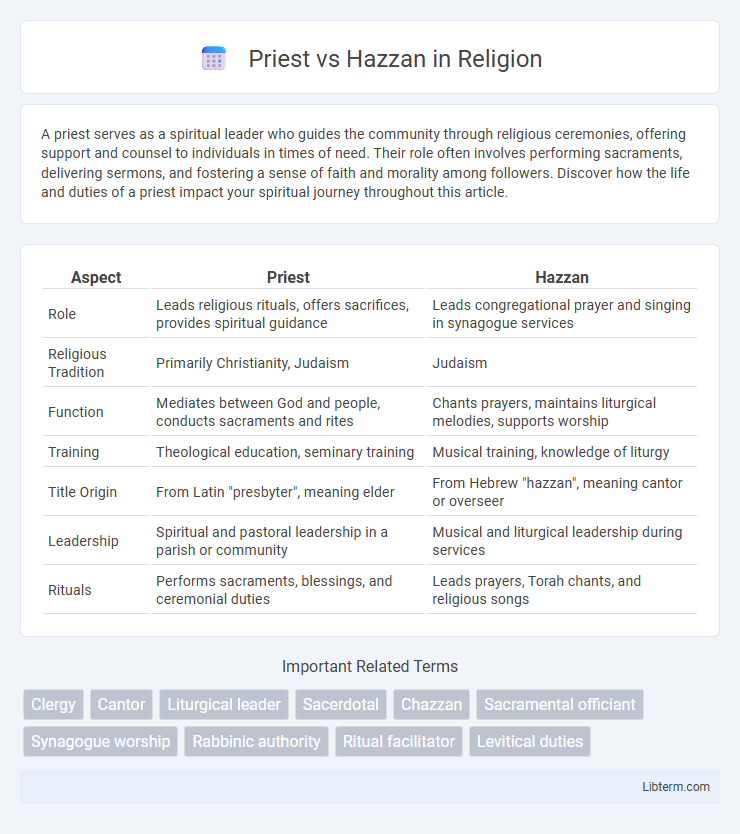A priest serves as a spiritual leader who guides the community through religious ceremonies, offering support and counsel to individuals in times of need. Their role often involves performing sacraments, delivering sermons, and fostering a sense of faith and morality among followers. Discover how the life and duties of a priest impact your spiritual journey throughout this article.
Table of Comparison
| Aspect | Priest | Hazzan |
|---|---|---|
| Role | Leads religious rituals, offers sacrifices, provides spiritual guidance | Leads congregational prayer and singing in synagogue services |
| Religious Tradition | Primarily Christianity, Judaism | Judaism |
| Function | Mediates between God and people, conducts sacraments and rites | Chants prayers, maintains liturgical melodies, supports worship |
| Training | Theological education, seminary training | Musical training, knowledge of liturgy |
| Title Origin | From Latin "presbyter", meaning elder | From Hebrew "hazzan", meaning cantor or overseer |
| Leadership | Spiritual and pastoral leadership in a parish or community | Musical and liturgical leadership during services |
| Rituals | Performs sacraments, blessings, and ceremonial duties | Leads prayers, Torah chants, and religious songs |
Introduction: Priest vs Hazzan
A Priest, or Kohen, serves a hereditary role in Jewish religious ceremonies, responsible for performing sacred rites and blessings in the Temple and synagogue. A Hazzan, also known as a cantor, is a trained vocalist who leads the congregation in prayer through liturgical chanting and music. Both roles are integral to Jewish worship but differ in function, lineage requirements, and ritual responsibilities.
Historical Origins of Priests and Hazzans
Priests, or Kohanim, originate from the biblical lineage of Aaron, brother of Moses, serving as sacred intermediaries in ancient Israelite religious practices, performing rituals and sacrifices in the Temple. Hazzans, also known as cantors, emerged much later in Jewish history as trained liturgical singers responsible for leading the congregation in prayer, their role becoming more defined during the medieval period. The historical origins of priests are deeply rooted in temple worship, while hazzans developed as central figures in synagogue services, reflecting evolving Jewish worship practices over centuries.
Roles and Responsibilities
A Priest (Kohen) primarily performs sacrificial rites, blessings, and maintains ritual purity within Jewish tradition, serving as a religious leader and mediator in temple services. The Hazzan functions as the cantor, leading congregational prayer through melodic chanting and guiding worshippers in liturgical practices during synagogue services. Both hold significant spiritual roles, but the Priest's responsibilities are rooted in ancient rituals, whereas the Hazzan focuses on communal worship and musical leadership.
Religious Rituals and Ceremonies
Priests (Kohanim) in Judaism perform specific religious rituals such as the Priestly Blessing (Birkat Kohanim) and offerings in the Temple, emphasizing their hereditary role in sacred ceremonies. Hazzanim (cantors) lead congregational prayers, chant liturgical texts, and guide the musical aspects of synagogue services, enriching communal worship through vocal artistry. While priests focus on ritual purity and temple rites, hazzanim specialize in enhancing prayer experiences and maintaining liturgical traditions during religious ceremonies.
Training and Ordination Requirements
Priests in Judaism, known as Kohanim, inherit their status through patrilineal descent and do not require formal training or ordination, while Hazzanim (cantors) undergo extensive religious and musical training, including courses in liturgical chanting, Hebrew language, and often formal ordination programs. Hazzanim typically attend specialized cantorial schools or seminaries, receiving certificates or ordination that authorize them to lead synagogue services and perform ritual chants. In contrast, Kohanim perform specific ceremonial roles based on hereditary status without the need for standardized ordination or professional training.
Liturgical Functions and Leadership
A priest (Kohen) in Jewish tradition primarily performs sacrificial rites and offers blessings within the Temple, maintaining a hereditary lineage and ritual purity. A Hazzan (cantor) leads the congregation in prayer through melodic chanting and is responsible for guiding communal worship services, often trained in liturgical music and vocal technique. While the priest's role centers on ritual officiation and sacramental duties, the Hazzan's focus lies in enhancing spiritual experience and congregational participation through liturgical leadership.
Clothing and Religious Symbols
Priests in Judaism, known as Kohanim, typically wear a white robe called a kittel during religious ceremonies, symbolizing purity, while Hazzans (cantors) often dress in traditional prayer shawls (tallit) and kippahs that reflect their role in leading congregational prayers. The kohen's vestments during Temple service historically included distinctive garments such as the ephod, breastplate, and mitre, which carry deep religious symbolism linked to their priestly duties. In contrast, the hazzan's attire focuses more on practical liturgical clothing that facilitates vocal leadership, often complemented by a yad, a pointer used when reading the Torah.
Community Involvement and Duties
Priests, known as Kohanim in Judaism, play pivotal roles in community rituals such as blessing congregants during services and performing specific rites in the Temple, emphasizing their hereditary status and ceremonial duties. Hazzanim, or cantors, lead the congregation in prayer through specialized liturgical chanting, facilitating spiritual engagement and enhancing communal worship experiences. Both figures contribute to community cohesion, with Priests focusing on ritual purity and sacred rites, while Hazzanim foster participation and emotional connection through music and prayer leadership.
Differences in Worship Practices
Priests (Kohanim) in Jewish worship perform specific ritual duties such as blessing the congregation with the Priestly Blessing (Birkat Kohanim) during services, a role not typically assigned to the Hazzan (cantor). The Hazzan leads the congregation in prayer and chanting, utilizing melodic and liturgical skills to guide communal worship without performing priestly functions. While the Priest's role is hereditary and ritual-specific, the Hazzan's role centers on musical and prayer leadership, shaping the spiritual atmosphere during services.
Modern Perspectives on Priests and Hazzans
Modern perspectives on priests and hazzans highlight their evolving roles within religious communities, where priests primarily perform sacramental duties in Christian contexts, while hazzans lead Jewish liturgical chanting and spiritual songs. Increasingly, both roles adapt to contemporary congregational needs, integrating technology and inclusive practices to engage diverse worshippers. Their shared emphasis on spiritual leadership and community cohesion reflects changing religious dynamics in a multicultural society.
Priest Infographic

 libterm.com
libterm.com